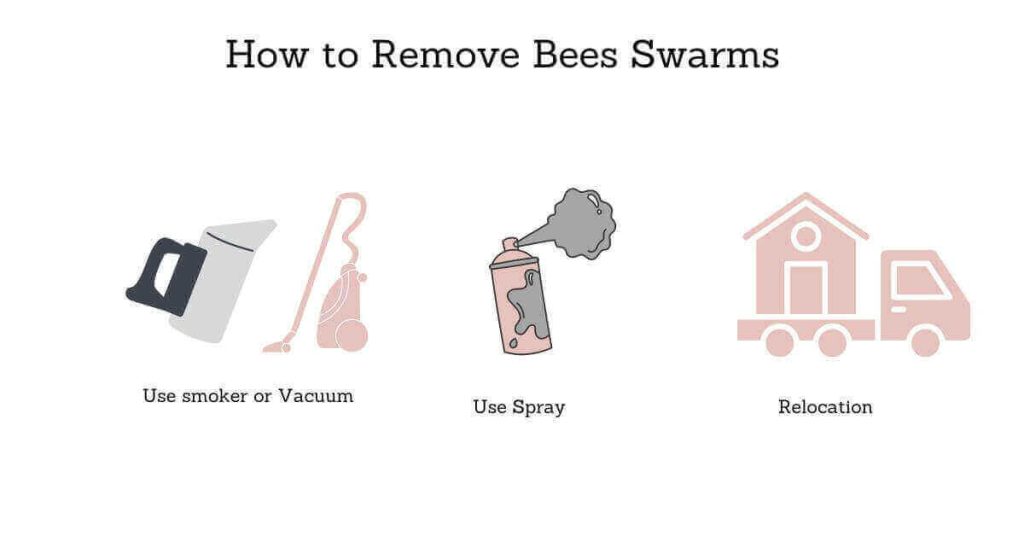Bee infestation refers to a colony of bees establishing a home within a structure, such as a wall or roof of a building. The bees will build a wax comb and store honey inside the structure, which can cause damage and attract other pests. Over time, the population of bees can grow, making it more difficult to remove the infestation. Bee infestations can also threaten human health, as the bees may become aggressive and sting those who approach their colony.
Sign of Bee Infestation
The most obvious signs of bee infestation is the presence of a large number of bees in a specific area, such as a home, garden, or other outdoor space. Usually we Learn to know about signs of bees in walls Other signs of bees include:
| 1 | Swarming or clustering of bees around a specific location. |
| 2 | Seeing bees coming and going from holes or cracks in walls or other structures. |
| 3 | Hearing the buzz of bees inside walls or other structures. |
| 4 | Finding honeycomb or beehives in attics, walls, or other hidden areas. |
| 5 | Discovering dead bees near the infested area. |
| 6 | Seeing large numbers of bees foraging for nectar and pollen in gardens or flowering plants. |
| 7 | Observing bees hovering around a particular area for extended periods of time. |
Causes of Bee Infestation.
The major steps of a bee infestation are as follows:
Bees search for a suitable location
Scout bees from a swarm of honeybees are sent out to find a new home. They look for protected, dark, and sheltered spaces, such as inside a wall or roof of a building.
Establishment of a colony
If a scout bee finds a suitable location, it will return to the swarm and communicate the location to other bees. The swarm will then move into the new location and establish a colony.
Building of comb
The bees will begin to build wax comb within the structure, laying eggs and storing honey. The comb may grow to several feet in size and cause damage to the building if left unchecked.
Increase in population
When a colony grows, the number of bees increases, making it more difficult to remove the infestation.
Honey production
As the colony matures, the bees will begin to produce honey, which can cause a sticky and unpleasant odor in the structure.
Aggression
Bees become more aggressive when a colony grows, making it dangerous to approach the infestation.
Quick & easy ways to Remove Bees Swarms
Here are some easy methods to remove bee swarms:

Smokescreen
Bees are attracted to light, so using smoke to create a smokescreen can effectively distract and disorient the bees, making it easier to remove the swarm.
Vacuum
A powerful vacuum can suck up the bees and relocate them to a new location. This technique is best performed by a professional, requiring specialized equipment and knowledge of bee behavior.
Sugar Water Spray
Spraying sugar water on the bees can make them sticky, making it easier to remove the swarm. This technique is effective, but it is important to note that it can harm the bees and is not recommended for those allergic to bee stings.
Relocation
Relocating the bees to a new location, such as a bee box or hive, can effectively remove a swarm. This method requires a beekeeper who has experience handling bees and a suitable location for the bees to establish a new colony.
Steps to Remove Swarms
Assess the situation
Before attempting to remove a bee swarm, it is important to assess the location, size, and behavior of the swarm. Suppose the swarm is located in a high-traffic area or threatens human safety. In that case, it is best to call a professional beekeeper or pest control expert.
Wear protective gear
When removing a bee swarm, it is important to wear protective gear, such as a bee suit, gloves, and veil, to minimize the risk of bee stings.
Locate the queen bee
The queen bee is the center of the bee colony, and removing her can help to break up the swarm. The queen bee is usually larger and has a distinctive appearance.
Related Articles:
Removal Bee swarms as a Local beekeeper

Aggravating the bees
Aggravating the bees by swatting at them or making sudden movements can increase the risk of bee stings and make the removal process more difficult.
Ignoring safety precautions
This step is most important. Ignoring safety precautions, such as wearing protective gear or avoiding sudden movements, can increase the risk of bee stings and make the removal process more difficult.
Relocating the bees to the wrong location
Relocating them to the wrong location, such as a location that is too hot or cold, can harm the bees and reduce their chances of survival.
Avoid these steps during bee swarm Removal.
If you and your Local beekeeper don’t have any Facilities to remove bees, what can you do in this condition? Follow these steps to remove a bee swarm as a local beekeeper:
| 1 | Identify the bee species and assess the swarm’s location to ensure safety. |
| 2 | Protect your body with a bee suit, veil, gloves, and hat. |
| 3 | Locate the queen bee and gently scoop her up into a cardboard box or a small hive with holes for ventilation. |
| 4 | Place a cloth or wax foundation in the box/hive to encourage the other bees to follow. |
| 5 | Please wait for the rest of the swarm to move into the box/hive and then cover it with a lid. |
| 6 | Transport the bees to a new location, either a permanent colony or a temporary holding area. |
How to contact an Beekeeper for bee extermination?
Exterminator for bee You can call a local beekeeper or a bee removal service to remove a bee swarm in the wild. Here are a few options for finding a beekeeper or bee removal service near you:
- Contact your local cooperative extension office. They may have a list of beekeepers in your area who can assist with bee removal.
- Check the Yellow Pages or an online directory for bee removal services in your area.
- Visit websites such as the American Beekeeping Federation (ABF) or the Beekeepers Association of your state and search for a list of beekeepers in your area.
Unfortunately, I do not have a specific bee removal service number, which would vary based on your location. I suggest using the above methods to find a local service.
Summary
Bee infestations can be caused by a variety of factors, including the availability of nectar and pollen, the presence of a suitable nesting site, and environmental factors such as climate and weather conditions. To remove a bee infestation, it’s best to contact a professional pest control company. They will be able to safely and effectively remove the bees and their nests, and help prevent future infestations from occurring.




